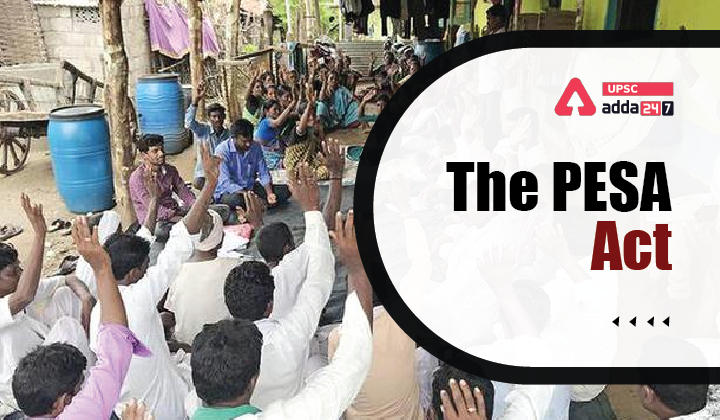Table of Contents
The PESA ACT- Relevance for UPSC Exam
General Studies II- Government policies and interventions for development in various sectors and issues arising out of their design and implementation.
In News
Aam Aadmi Party (AAP) leader Arvind Kejriwal on Sunday (August 7) declared a six-point “guarantee” for tribals in Gujarat’s Chhota Udepur district, including the “strict implementation” of The Panchayats (Extension to the Scheduled Areas) Act (PESA Act).
The PESA Act
- Under the PESA Act, Scheduled Areas are those referred to in Article 244(1), which says that the provisions of the Fifth Schedule shall apply to the Scheduled Areas and Scheduled Tribes in states other than Assam, Meghalaya, Tripura, and Mizoram.
Objective
- To extend the provisions of Part IX of the Constitution to Scheduled Areas, identified by the Fifth Schedule of the Constitution of India.
- To guarantee self-governance through traditional Gram Sabhas for people living in the Scheduled Areas of India.
- To provide tribals control and rights over the natural resources and conserves their identity and culture.
Historical Background
- The PESA Act was enacted in 1996 “to provide for the extension of the provisions of Part IX of the Constitution relating to the Panchayats to the Scheduled Areas”.
- Other than Panchayats, Part IX, comprising Articles 243-243ZT of the Constitution, contains provisions relating to Municipalities and Cooperative Societies.
Significance
- The PESA Act was enacted to ensure self-governance through Gram Sabhas (village assemblies) for people living in the Scheduled Areas.
- It recognizes the right of tribal communities, who are residents of the Scheduled Areas, to govern themselves through their own systems of self-government, and also acknowledges their traditional rights over natural resources.
- The Act empowers Gram Sabhas to play a key role in approving development plans and controlling all social sectors which includes
- Exercising control over minor (non-timber) forest resources.
- Minor water bodies and minor minerals.
- Managing local markets.
- Preventing land alienation.
- Regulating intoxicants among other things.
Implementation in States
- State governments are expected to amend their respective Panchayati Raj Acts without making any law that would be inconsistent with the mandate of PESA.
- Ten states — Andhra Pradesh, Chhattisgarh, Gujarat, Himachal Pradesh, Jharkhand, Madhya Pradesh, Maharashtra, Odisha, Rajasthan, and Telangana — have notified Fifth Schedule areas that cover (partially or fully) several districts in each of these states.
- After the PESA Act was enacted, the central Ministry of Panchayati Raj circulated model PESA Rules. So far, six states have notified these Rules, including Gujarat.
Gujarat’s Issue
- Gujarat notified the State PESA Rules in January 2017, and made them applicable in 4,503 gram sabhas under 2,584 village panchayats in 50 tribal talukas in eight districts of the state.
- The provisions of the law deem the Gram Sabhas as “most competent”.
- However, the Act has not been enforced in letter and spirit.
- The Act lays down that the state must conduct elections in such a way that the tribal representation is to be dominant in the Gram Sabha Committees.
- Yet again, there has been no attempt to proportionally increase the representation.
Previous Year Question
Q.The Government enacted the Panchayat Extension to Scheduled Areas (PESA) Act in 1996. Which one of the following is not identified as its objective?
Solution- To create autonomous regions in tribal areas.
- Consider the following provisions under the Directive Principles of State Policy as enshrined in the Constitution of India :
- Securing for citizens of India a uniform civil code
- Organizing village Panchayats
- Promoting cottage industries in rural areas
- Securing for all the workers reasonable leisure and cultural opportunities
Q.Which of the above are the Gandhian Principles that are reflected in the Directive Principles of State Policy?
(a) 1, 2 and 4 only
(b) 2 and 3 only
(c) 1, 3 and 4 only
(d) 1, 2, 3 and 4
Solution (b)
Q.The Constitution (Seventy-Third Amendment) Act, 1992, which aims at promoting the Panchayati Raj Institutions in the country, provides for which of the following?
- Constitution of District Planning Committees.
- State Election Commissions to conduct all panchayat elections.
- Establishment of State Finance Commissions.
Select the correct answer using the codes given below:
(a.) 1 only
(b.) 1 and 2 only
(c.) 2 and 3 only
(d.) 1, 2 and 3
Solution (c)
Q.How do District Rural Development Agencies (DRDAs) help in the reduction of rural poverty in India?
- DRDAs act as Panchayati Raj Institutions in certain specified backward regions of the country.
- DRDAs undertake area-specific scientific study of the causes of poverty and malnutrition and prepare detailed remedial measures.
- DRDAs secure inter-sectoral and inter-departmental coordination and cooperation for effective implementation of anti-poverty programmes.
- DRDAs watch over and ensure effective utilization of the funds intended for anti-poverty programmes.
Which of the statements given above is/are correct?
(a) 1, 2 and 3 only
(b) 3 and 4 only
(c) 4 only
(d) 1, 2, 3 and 4
Solution (b)
Q.In the areas covered under the Panchayat (Extension to the Scheduled Areas) Act, 1996, what is the role/power of Gram Sabha?
- Gram Sabha has the power to prevent alienation of land in the Scheduled Areas.
- Gram Sabha has the ownership of minor forest produce.
- Recommendation of Gram Sabha is required for granting prospecting licence or mining lease for any mineral in the Scheduled Areas.
Which of the statements given above is/are correct?
(a) 1 only
(b) 1 and 2 only
(c) 2 and 3 only
(d) 1, 2 and 3
Solution (b)
Q.The Government enacted the Panchayat Extension to Scheduled Areas (PESA) Act in 1996. Which one of the following is not identified as its objective?
(a) To provide self-governance
(b) To recognize traditional rights
(c) To create autonomous regions in tribal areas
(d) To free tribal people from exploitation
Solution (c)




 TSPSC Group 1 Question Paper 2024, Downl...
TSPSC Group 1 Question Paper 2024, Downl...
 TSPSC Group 1 Answer key 2024 Out, Downl...
TSPSC Group 1 Answer key 2024 Out, Downl...
 UPSC Prelims 2024 Question Paper, Downlo...
UPSC Prelims 2024 Question Paper, Downlo...




